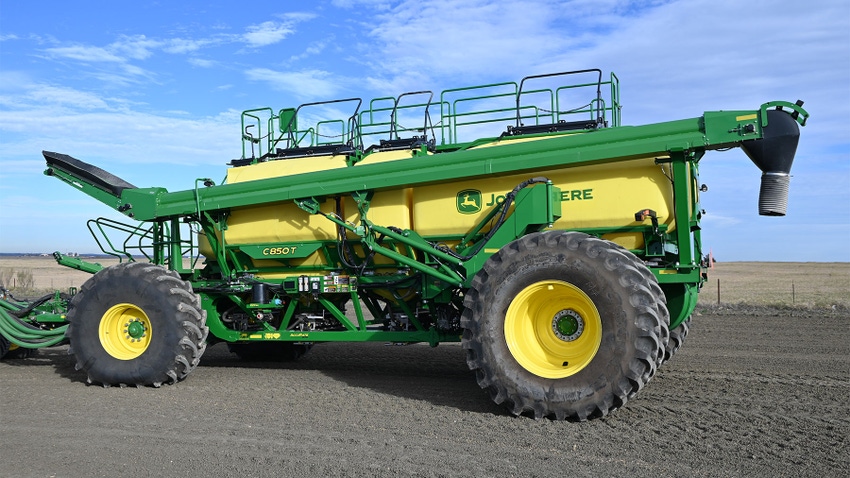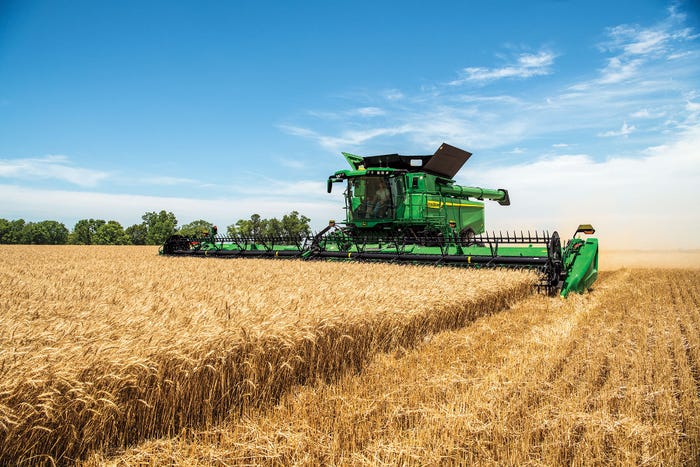
A new air-seeder cart and new S7 combine are in the works for John Deere’s 2025 lineup, the company announced at this week’s Commodity Classic in Houston.
The new C-Series carts come with a new automated calibration system, stainless steel electric meters and a new naming convention.
Anthony Styczinski, go-to-market manager for John Deere planting and seeding, says the cart’s new meters are electrically controlled to run high-fidelity prescriptions.
“So, we can be eight times more accurate than what we were able to do with our previous meters,” he says.
Along with that, the carts come with Deere’s new EZCal system, which Styczinski says can calibrate 45% faster than competitor models. A built-in tank eliminates user interaction and sends data to the cab while tendering continues.
“So, you can start the system, walk away from it, and it will do that automatically,” Styczinski says.
Other features include tank scales on all models — they were previously not offered on the 1910 air seeders — blower automation and a new cart-side display.
The C-Series comprises 11 different carts with a new naming convention that shows cart capacity in bushels and either an L for leading or T for trailing, starting with the C350L and C350T; C400L and C400T; C500 L and C500T; C550L and C550T; C650L and C650T; and the C850T.
Here’s a clip of the new C-Series cart:
S7 combine
The new S7 combines are similar to the X9, but with newer features and electrical architecture for future autonomous operation.
Bergen Nelson, go-to-market manager for John Deere combines, says the new machines focus on increased efficiency, enhanced operator experience and a new technology package.
On the tech side, the new combines are equipped with predictive ground speed automation and enhanced harvest settings automation.
“It is really the groundwork for future autonomy within the S series combines,” Nelson says.
The new models start with the S7 600, rated at 333 hp, max 367 hp; S7 700, rated at 402 hp, max 460 hp; S7 800 with 473 hp, max 523 hp; and S7 900 with 543 hp, max 593 hp.
The 600 and 700 models come with 300-bushel tanks, while the 800 and 900 have 400-bushel tanks.
The 600 and 700 are powered by 9.0-liter engines, while the 800 and 900 are powered by 13.6-liter engines already on the X series combines.

S7 COMBINE: The new S7 combines are similar to the X9, but with newer features and electrical architecture for future autonomous operation. (Photo courtesy of John Deere)
The combines also come with a new in-line after-treatment system and new residue system, like what’s on the X series. They also come equipped with the new X series cab, adjustable spout and cross auger shutoff, and a new cab entry.
Predictive ground speed automation uses six settings — predictive inputs, loss level, engine power limit, threshing load, terrain and coverage — to help the combine understand how to harvest within a field.
"You can kind of think about this as almost adaptive cruise control," Nelson says. “And it will be helped by stereo cameras on the combine to look out ahead of the machine and see the crop volume and height, and that will allow it to be predictive in how fast or slow the machine will go. The stereo cameras can see crop status 30 feet ahead.
"This is looking in front of the machine so we can be proactive in how we automate this machine," he adds.
Harvest settings automation will automatically adjust settings — such as concave clearance, sieve, chaffer, fan speed and rotor speed — based on one of three preset performance targets set by the operator: reduced grain loss, foreign material or broken grain. Once the performance target is set, Nelson says the machine will adjust itself.
In the past, he says, customers would set a performance target with harvest setting automation, and it could take up to 20 minutes for the combine to make the change. Now, once the settings are changed, it does it almost instantly.
The company will start taking orders in March.
Read more about:
CombinesAbout the Author(s)
You May Also Like






